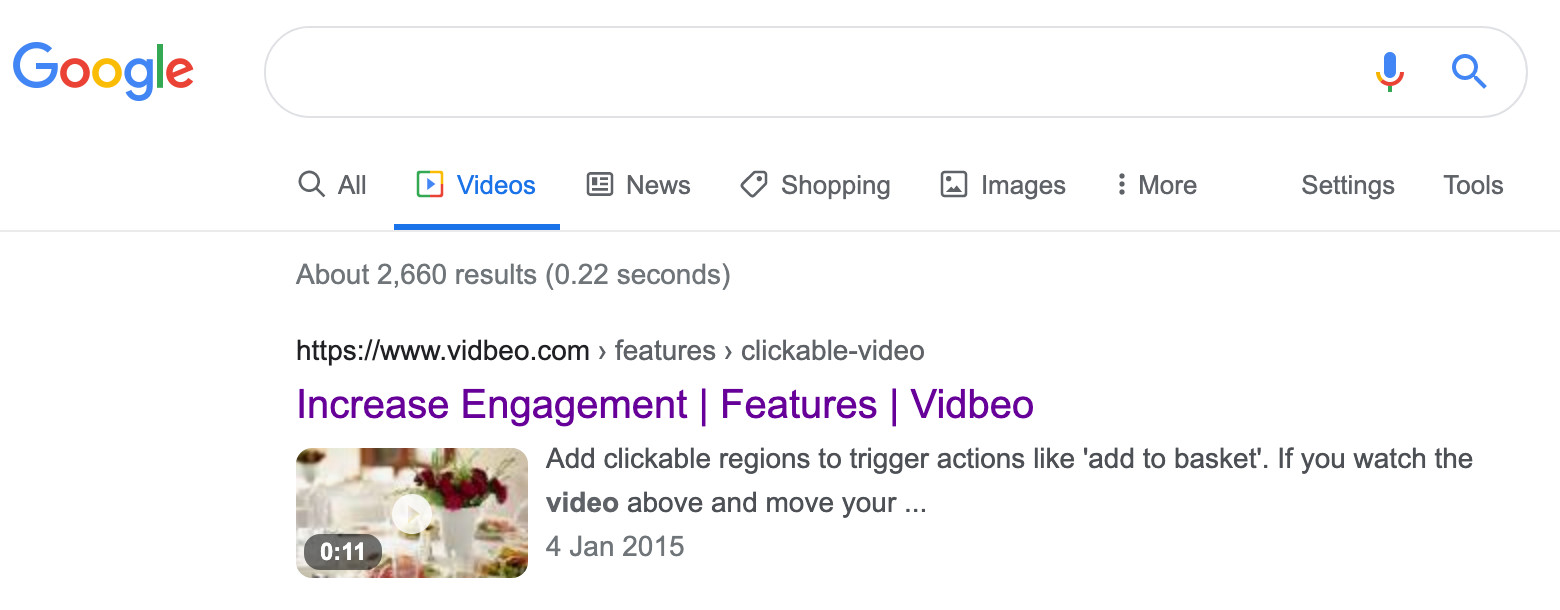What is video SEO?
Video results can stand out more within the competitive world of search engine result pages. If your video is considered to be a good match for a user’s search then a link to your video - on your site - would then be shown. If you can be higher ranked within the organic result pages, that lead from the resulting click does not cost anything to acquire (unlike a paid search ad). So it makes sense to keep that in mind when generating your content.
When you set a video’s privacy as public in our video CMS, we add extra metatags to the top of our embed code’s HTML. Those tell search engines and social media about the video, such as its title, description and thumbnail image. Adding those can help your video be indexed and displayed as such within social media like Twitter.
Generally only one video will be indexed on a page and so we recommend you only include one video on each page. Position it near the top. You can include multiple videos, however if you do make sure your attention is focused on that first one you want to target. Burying a video beneath the fold will mean it won’t be a user’s focus and so it likely won’t be a search engine’s focus either.
The title
Make sure the keyword you want to target appears in the video’s title. It may help if it is the first word in the title, however it is more important the title is natural and does not appear to be “keyword stuffing”, repeating a word or looking artificial. We recommend that the title is at least five words so that your keyword can appear organically within it. We recommend also adding a short description which includes it too. If you include a description for your video, we include it in the metatags.
The thumbnail
One of the key things to consider for video SEO is your video’s thumbnail image. When you upload a video using our video CMS, we will automatically generate a thumbnail. That is usually taken from half-way through your video. That may be suitable. However to stand out on search engine result pages, you may want to use an image that stands out more, whether another frame from that video or indeed an image not within it at all. Perhaps by merging images, like including a logo or reaction shot. You may want to consider an image of someone doing what your video is about, particularly in the case of a tutorial. If your video is about learning to ski, an image of someone skiing is likely to work better in search results than a picture of a mountain. You can use our video platform to upload your own, custom thumbnail image. Make sure it is a suitable format (in our case we support JPEG .jpg) and upload that from within the Thumbnail tab on your video’s page within our dashboard. That is then replaced within a few seconds and used as the image to represent the video.
The duration
Search engines want to present users with high quality results relevant to their query. If videos are to appear highly ranked then it follows they need to be high-quality content. Increasingly YouTube is targeting time watched over number of views as a measure of quality, and so it makes sense that if your video is at least five minutes, that equates to more time watched. Of course the video should not be padded with unnecessary content however if you can go into more detail about a particular topic, and youu find your viewers respond well, it is likely search engines will too.
The videos tab
Since Google is the dominant search engine, it is where most attention is focused. On a Google search result page there is the initial universal search result page, All, and then sub-pages under tabs (for Images, Shopping, and the applicable one here, Videos). It seems easier to get a page to appear listed under Videos. However that is likely because it is a subset of the available results for that query, and so it should be easier to be higher ranked. If the user happens to be looking specifically for a video (for example if they are after a tutorial video about a particular topic) then they may well click on the Videos tab to spcifically see the ones listed:

Videos are ranked by relevance so make sure its content is indeed relevant to your target keyword(s).
Page content
You need to consider the rest of the page’s content too. The text should be relevant and complement the video. Pay attention to the title tags, such as H1 and H2. Be sure to include the words you want to be found using within the title and in the body copy, with variations too.
What are people looking for
Handily Google provides free tools to let you find out people are searching for. Find out what topics are popular at the moment with Google Trends. That may help guide the type of content you are creating. Target by region to see what is popular in your country. You don’t see raw numbers but you can at least see relative performance.
Google provides a similar tool for their AdWords product: keyword planner.
Other options
While appearing in the organic search results is most appealing (because it is free to generate that traffic) you may also want to consider paid options, such as pay-per-click search advertising and promoting your content on social media like Twitter and Facebook. Some of the same considerations still apply, such as the choice of title and thumbnail image. However because it is the interest of that platform to drive visitors to your site (to result in a paid-for click, and so a payment to them), it is worth experimenting with.
Updated: February 25, 2021